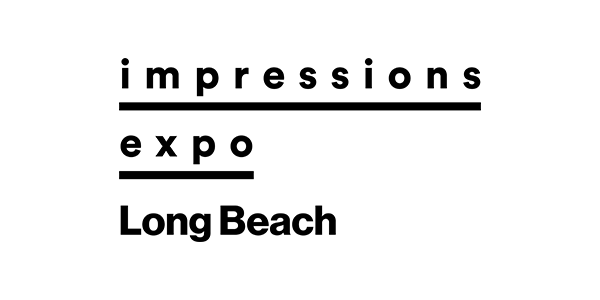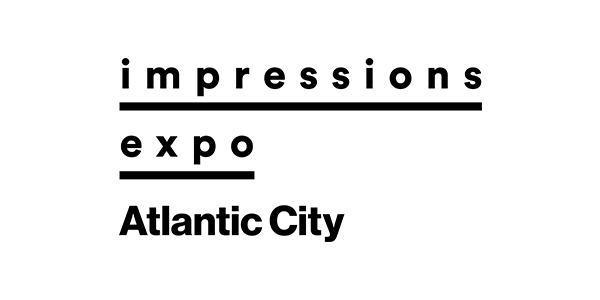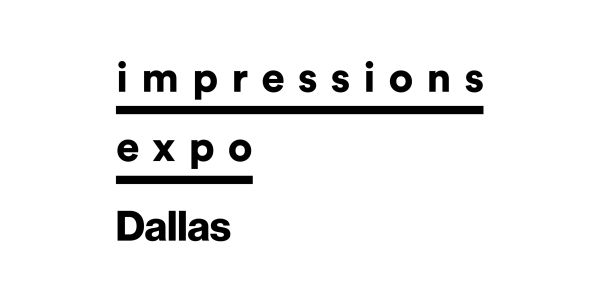In Spectrum Designs’ screen-printing darkroom, Spencer Pusey—aka “The Dark Knight”—handles everything from cleaning to exposing screens. A former grocery bagger turned decoration specialist, he also stars in a number of different instructional videos showing other employees how it’s done. “I cover the entire area. I have a sense of responsibility and a [sense] of duty to help make this company great…it’s really satisfying that I can print things that make our customers happy,” says Pusey, a neurodivergent individual, of his work with Spectrum, a unique print shop where the focus is as much on the people who work there as it is branded merchandise.
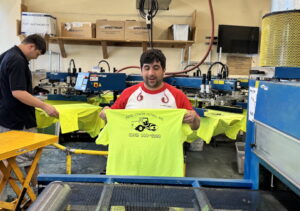
Spencer Pusey—aka “The Dark Knight”—is a jack of all trades at Spectrum. Photo courtesy of Spectrum Designs
Spectrum Designs (spectrumdesigns.org), which prints around 10,000 items a day, is a nonprofit decorating company in which over 70 percent of the employees are on the autism spectrum or neurodivergent. With locations in Port Washington and Pleasantville, New York, Spectrum has been creating career opportunities for neurodivergent individuals since 2011. Today, the shop offers screen printing, embroidery, digital printing, pad printing, graphic design and a variety of promo products. It also performs bulk runs of 100,000-plus imprints for such brands as ABC, Uber, 1-800-Flowers.com, Google, J. Crew, and J.P. Morgan Chase—all in service of its mission: “To create meaningful and inclusive employment and vocational training opportunities in a neurodiverse world.”
When the bus stops coming
Back in 2010, the sudden passing of Paul C. Kitsos, a women’s apparel company owner whose son is on the spectrum, inspired his family to launch the Nicholas Center for Autism (named for Kitsos’ son) along with an accompanying employment initiative, Spectrum Designs Foundation. Co-founders Patrick Bardsley (Spectrum’s current CEO), Stella Spanakos and Nicole Sugrue started out with just a pair of employees on the autism spectrum and a single decorating machine in a converted barn behind Spanakos’ Long Island home. It didn’t take long, though, for things to take off from there.
Bardsley, who’d previously worked at a special needs camp in upstate New York, says the company he now runs is in many ways a response to an alarming trend he noticed among young people on the spectrum, in particular. “We’d have the same conversations with parents, caregivers and campers. ‘What happens next when I get older? What happens when the school bus stops coming?’” he says. “I knew that someone had to tackle this. My cofounders are mothers of adults on the spectrum, and they agreed.”
The idea of going into the decorating business stemmed from the many walks, volleyball tournaments and other fundraising events the autism community organizes that include printed T-shirts and merch. “We thought if we could print those T-shirts, perhaps the community would order from us, and it blossomed from there,” Bardsley says. “From working just with the autism community, we started getting business from moving and self-storage businesses, delis, pizza shops and even country clubs. It kept getting bigger.”
In the wake of this initial success, Spectrum was able to hire yet more educational staff and production directors at the same time it was able to provide a growing number of employment opportunities for the people it was looking to help.
In 2012, for example, its partner organization, The Nicholas Center, purchased a 500-square-foot building in order to provide the necessary space for Spectrum Designs to substantially expand its operations, after which it moved yet again to a 1,500-square-foot location in the Community Chest building in Port Washington.
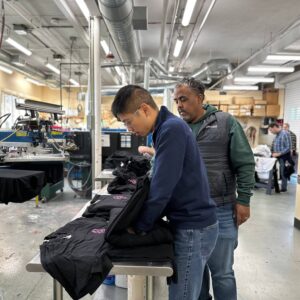
Jason (left) and operations manager Miguel Guerrero hard at work on the production line. Image courtesy of Spectrum Designs
In 2015, Spectrum acquired its first automatic screen-printing press, allowing it to grow its production by 500 percent, creating yet more work for its employees, increasing output capacity, and enabling it to be that much more competitive on price, volume and consistency.
By 2017, Spectrum’s end-of-year sales had grown 60 percent to an impressive $2.4 million, allowing it to relocate to a new flagship location in Port Washington, tripling its production space and expanding hiring capabilities.
Eventually, Spectrum signed a lease for its 8,000-square-foot facility in Pleasantville, where the team’s first order was a 5,000-piece contract from the local Metro-North railway. At the same time, the team continued making strides in terms of its workforce, welcoming 11 graduates from its newly created Screen Print Certification Course and expanding to 51 neurodiverse employees by the end of 2020.
Since then the shop has continued to grow across both locations, further expanding its neurodiverse team, increasing output and creating tens of thousands of hours of paid employment and vocational training for individuals on the autism spectrum—at the same time hitting nearly $7 million in revenue.
“We always prioritized delivering quality products on time, offering amazing customer service and being price competitive, which allowed us to be a contender in the apparel-decorating industry,” Bardsley says.
“In the beginning, especially in the earlier days…a lot of people were concerned about the quality of the product or the pricing, or that we’d miss their deadline. They also heard about our mission as a nonprofit, and thought, ‘Alright, I want to help the kids…but I need my stuff on time,’ or ‘I guess you’re going to be a lot more expensive,’ or ‘Can you give us references?’ That fueled our desire to prove people wrong.”
Hiring across the spectrum
Interestingly, in terms of the day-to-day, the shop’s challenges are in many ways no different from those any business would face. “You know, customers, deadlines, busy seasons, quiet seasons and staff turnover,” Bardsley says. That said, when it comes to staffing, while the workforce at Spectrum may require some extra effort in some areas, it also offers a number of advantages, due to the fact many of the people who work there also have above-average skills in the areas of memory, pattern recognition and mathematics.
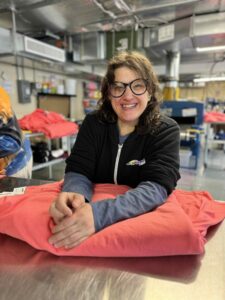
Spectrum’s emphasis on team building ensures every voice is heard, including those of production floor workers like Sherri. The result is a shop that is as productive as it is efficient. Photo courtesy of Spectrum Designs
“When we started this almost 15 years ago, the term ‘neurodiversity’ wasn’t even a term—at least not one that was widely used,” Bardsley says. “[The idea of neurodiversity] is helpful, though, because it’s a strength-based approach. Instead of implying that someone is ‘less than able,’ it just acknowledges that the brain works differently—and that’s a strength.”
With this in mind, Bardsley says, when it comes to the decorated apparel industry it in many ways makes an ideal fit for the neurodivergent population. “It’s concrete and objective. You start with a blank product, follow clear steps and end with a finished item,” he says. “That structure, along with the repetition and attention to detail the work requires, aligns with the strengths of many people on the spectrum.”
Granted, one of the challenges many neurodivergent workers face is in the area of social interaction. However, Bardsley says, “We’re not putting people on a checkout line or at an airport help desk. We’re playing to their strengths. When people think differently, you get different—and often better—ideas at the table. That’s where the creativity and problem-solving shine.”
“There are so many people who have issues getting labor in our industry,” he says. “And we’re like, ‘There’s this whole pool of people over here that you’re not looking at.’ You need to start because not only will they help with your labor challenges, but we’re also proving that they can make you a better company as a whole.”
A more inclusive—and effective—workspace
Bardsley, who earned his master’s in special education before becoming a custom decorator, says he never thought he’d be printing T-shirts and promo products as a career. It just ended up that way.
“We outsourced at first, but then realized we could employ neurodiverse people by bringing the decorating techniques in-house,” he said. “Since I understood the population, I looked at how we could break down the process to clean embroidery backing or print a T-shirt, for example, and have it work for them.”
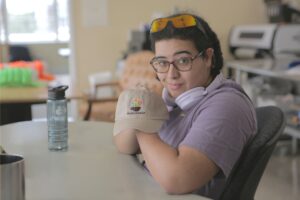
Tara hard at work in Spectrum Design’s embroidery department. Image courtesy of Spectrum Designs
In order to make this possible, Bardsley says, one of the priorities at Spectrum has been to create a visual shop with plenty of cues, instructions and tools to aid in the decorating process. For example, they cut a semicircle in a small piece of plexiglass so that when a team member is removing embroidery stabilizer, they can pull the decorated part through the opening and avoid cutting the shirt. They’ve also labeled each machine with its name and number, and numbered each part an operator uses. Similarly, footprints on the floor indicate where to stand; markers on the dryer belt show where to remove each garment so it isn’t taken off too quickly; and a laser-guided alignment system projects precise placement guides onto garments for accurate direct-to-film (DTF) transfer positioning.
“Yes, we’ve made these accommodations to help our employees on the spectrum, including letting them wear headphones for noise sensitivity, but it’s increased our overall efficiency by 30 percent as well,” Bardsley says. “These things cost very little, but make a huge difference because every shop owner wants efficiency and productivity. The best way to get that is if people are comfortable and happy in what they’re doing.”
By way of example, so detailed and comprehensive are the instructions that have been put in place, Dylan Valic, Spectrum’s head of marketing and a neurodivergent individual as well, notes he had no trouble getting up to speed when it came time to help out one day with some orders. “Even as someone with no experience, I figured it out because signs were telling me what to do,” Valic says. “I could be a productive member of the team.”
Beyond that, depending on an employee’s capabilities, Spectrum offers a variety of different levels of support. “We’ve always philosophically hired across the autism spectrum, from folks…who just need a few executive functioning skills all the way to people who need one-on-one support,” Bardsley says. “In the middle is the largest group, probably about 50 percent to 60 percent of those diagnosed on the spectrum, [who] can work in modified settings with a single job coach for every three or four people.”
As for those who need one-on-one support, Bardsley says they do their part as well. “We’ve found stuff they can do in a print shop,” he says, “even if it’s just catching at the back of the tunnel where the shirt comes through and stacking them in size order.”
Which is not to say each and every person working at Spectrum isn’t pulling their weight. Just the opposite. The organization may be a not-for-profit, but it keeps a clear eye on the bottom line. Nor does it mean any member of the team is in any way less important than anyone else. Everybody has a voice. “If somebody is on the floor doing this one job and they’re like, ‘This isn’t working or we should change it, we take it seriously and make the change,” Bardsley says.
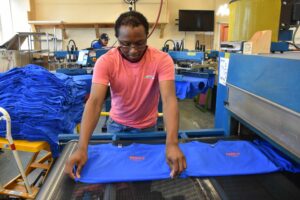
The workforce may not be quite the same at Spectrum as it is elsewhere, but the quality and service the shop provides are second to none. Here, Spectrum’s Jarrius places newly screen-printed T-shirts on a drying conveyor for curing. Photo courtesy of Spectrum Designs
At the same time, while Spectrum looks at profitability as one measure, Bardsley says the company also considers the number of hours of employment its creates for people who are neurodiverse or on the autism spectrum—each and every one of which is paid minimum wage or more, sometimes with “benefits and perks of employment even beyond our industry,” Bardsley says.
Specifically, according to Bardsley, “We do an annual survey about other impacts, like increasing feelings of self-worth and confidence, gaining independence by saving money and getting your housing, and building relationships because employment is more than the paycheck.”
Finally, Spectrum makes a concerted effort to push the envelope in terms of the roles its neurodivergent workforce occupies. For years, for example, Spectrum was a company where people with disabilities worked pretty much exclusively on the shop floor or in the warehouse. “We patted ourselves on the back because it’s amazing,” Bardsley says of this initial success. “But we made a big shift when we started looking at adding roles where we didn’t have neurodiverse roles or voices, like in administration, marketing and management. Now we have voices at all levels, and it’s made us stronger.”
In addition, Bardsley says, “In the early days, people would say that after a certain amount of time with us, our employees would go ‘work in a real print shop.’ There was a mindset that we were a stepping stone.”
Since then, however, the focus has shifted from providing people with just jobs to fostering long-term careers. Case in point: after graduating from high school and working at a grocery store, Pusey joined Spectrum part-time in 2017 before transitioning into a full-time career in the decorating industry two years later.
Today Pusey goes wherever he’s needed on Spectrum’s production floor—catching, loading and jumping in on DTG or embroidery when the team is shorthanded. “I have a lot of fingers in different pies,” he says. “If the printers need a filler, I can be that filler. If they need a catcher, I’m that catcher. Sometimes it’s just printing. Sometimes it’s helping with DTG or embroidery—I’m their guy.”
Bridging the gap for screen-printing shops
Again, Bardsley is emphatic in his belief that there are plenty of other screen-printing shops out there that could benefit from hiring neurodivergent individuals or individuals on the autism spectrum as well. The problem, he says, is these shops may have misapprehensions about hiring the neurodivergent or don’t know where to start. “The biggest thing is fear,” Bardsley says. “No shop owner I know wants to be the bad guy that has to fire a person with a disability.” However, he says, the main thing with people with disabilities is that they ultimately want to be treated the same as everyone else. If they’re not doing the job, Bardsley says, it’s OK to let them go, the same as any other worker who might not be working out for some reason.

Like everyone at Spectrum Designs, Winston is a valued member of the team. Photo courtesy of Spectrum Designs
A good place to start for those interested in possibly hiring a worker, or workers with a disability, Bardsley says, is with a disability employment service provider. “Owners often don’t know about all the support out there that doesn’t cost shops anything,” he says. “You can find so many state-funded agencies that will help you find the right person based on your job description and provide job coaching. They’re just waiting for businesses to contact them, and they’ll find the right person.”
More specifically, he says, these kinds of providers will review your open positions or audit the tasks you need completed and then help find, screen, hire, onboard and train these employees at no cost. This includes both full and part-time workers. They’ll also train your managers and act as a resource to provide ongoing coaching and even onsite support.
In addition to connecting with a federally funded vocational rehabilitation office at the state level, he says, shops can also contact organizations like The Arc (thearc.org), a not-for-profit dedicated to advocating for people with disabilities and their families. Another good place to start is with APSE (apse.org—the Association of People Supporting Employment First), a national trade organization for disability employment service providers.
A true team effort
With respect to its success so far, ultimately, Valic says, he believes Spectrum’s greatest strength is its people. “We have so many unique personalities here, and there’s a story behind every person,” he says. “We like to say miracles happen here every day because we have managers on the autism spectrum teaching neurotypical people how to do their jobs. We have people who were told they would never work a day in their lives producing merchandise for Microsoft, Uber and Google.”
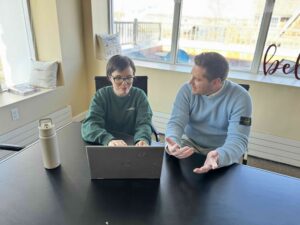
Bardsley talks marketing strategy with Spectrum’s Kelli Fisher. Image courtesy of Spectrum Designs
Not only that, but thanks to the efforts of Valic and the company’s head of social media, Kelli Fisher, who is also on the spectrum, the business has increasingly been able to spread the word by making a name for itself online. The team was also featured earlier this year on The Kelly Clarkson Show and in the 2018 documentary film, “This Business of Autism.”
“The Spectrum story is that we’ve created a place where we can be ourselves, and our social media reflects this,” Valic says. “Now we’re more off the cuff, for example, asking our employees a question and seeing what they come up with. One video that got over 10,000 views was about what our employees would do if they won the lottery.”
Valic notes he especially loves getting messages from people living in other parts of the world, from the U.K. to Japan, saying they found out about the business on social media, and it’s provided them with a renewed sense of what may be possible for their child. “We’re using social media to share our mission and sell products,” he says. “But it’s also spreading hope.”
For too long, Bardsley says, people with disabilities were segregated in institutions or out-of-the-way housing. “Now, they’re celebrated,” he says, noting that’s one of the reasons the company’s Port Washington facility is located where it is, on Main Street no less: “to be part of the community, near restaurants and transport hubs…our employees are spending their wages in local businesses and paying income tax. It’s a hand up, not a handout.”
Which is not to say the rest of the world doesn’t still have a long way to go.
“Unfortunately, we continue to have this really high unemployment rate for adults on the spectrum,” Bardsley says. “We’re at a 70 percent unemployment rate for people with disabilities in New York State, closer to 80 percent to 85 percent nationwide. They’re twice as likely to be in the prison population. Generational poverty is still high. The data is the data, so we have a lot of work to do.”
Nonetheless, as word gets out, there’s reason for optimism, and the decorated apparel industry very much has a role to play—if it’s willing. As Pusey says, “If every crayon in the box were the same color, it wouldn’t be much of a crayon box, would it? It would just be, ‘Here’s a bunch of red crayons. Have fun picking your favorite form of red.’”
Words to live by, especially when it comes to a business that celebrates creativity and diversity the way the decorated apparel industry does. The more colors the better. So why not take a chance on some of those other colors as well?
Nicole Rollender is an award-winning writer and heads the copywriting and content-creation firm STRANDWritingServices.com.



